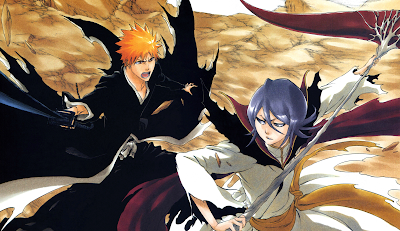This month marks 4 years since I submitted my first published article, and therefore marks my anniversary of being a professional writer! To mark the occasion, here is the very first article, which has never been published online before, and can only be found in print if you can track down a back issue of MyM #1 (good luck with that!)
This article first appeared in MyM Magazine Issue 1 (May 2012)
Tite Kubo's Bleach is unquestionably one of the most successful anime and manga franchises of the last decade or so. Since it began publication in 2001 in Weekly Shonen Jump it has racked up more than fifty volumes of manga, in excess of three hundred episodes of the anime, a mountain of merchandise and numerous videogames. It has even spawned a rock musical and there is a live-action Hollywood adaptation in the pipe-line.
In case you've been living under a rock, Bleach follows the exploits of Ichigo Kurosaki, a Japanese high-schooler with a sixth-sense style ability to see dead people. While most kids his age are happy with a paper round or working in a local shop, Ichigo has a most unusual part-time job ; substitute Soul Reaper (Shinigami or Death God in the original Japanese).
The anime TV series first began airing in October 2004, with the last episode airing on March 27th 2012. As with most long-running anime it has also involved a number of feature-length releases, with four having hit the big screen in Japan to date. This May sees the first three movies make their UK high-definition debut, when they are released on Blu-ray for the first time.
Bleach's first theatrical outing Memories Of Nobody hit Japanese cinemas in December 2006. As with the films that would follow, it was directed by Noriyuki Abe (who also directed the series) and featured original characters designed by Tite Kubo himself. The movie introduced the concept of Blanks, souls who have lost their memories and are unable to pass on. Their sudden appearance in the land of the living seems to be connected with a new enemy who threatens to destroy both the world of the living and the Soul Society (Bleach's realm of the dead). The events also seem to be linked to the sudden arrival of a young Soul Reaper named Senna.
The following December saw the release of the second film The Diamond Dust Rebellion. It revolves around the stealing of a precious artefact known as The Kings Seal, an event in which diminutive Soul Reaper Captain Toshiro appears to be implicated. The division captain is charged with treason, leaving Ichigo to try and fight and clear his name.
The third feature, Fade to Black was released in December 2008, and is being released in the UK for the first time. The inhabitants of the Soul Society are attacked by a mysterious foe who kidnaps Rukia. The attack leaves the Soul Reapers stricken with amnesia that causes them to forget not only Rukia but Ichigo as well. Ichigo must try and rescue her and restore her memories, in a quest that will bring him into conflict with not only the kidnappers, but also his friends in the Soul Society.
If you're completely new to the world of Bleach and think the movies would be a good jumping-in point then think again. These are aimed very specifically at pre-existing fans and there is no allowances for the uninitiated. For those fans though, these movies provide just about everything they could want from a Bleach movie. They are essentially extended episodes of the TV series, but the animation quality is slightly slicker. The action set-pieces feel suitably cinematic and epic, making the most of a higher budget and longer running time. The kick-ass action Bleach excels at is here in abundance, surrounded by compelling drama and some big laughs. All in all, any Bleach fan worth their salt needs these films in their collection. And with the gorgeous new Blu-ray transfer, Bleach has never looked (or sounded) better.


No comments:
Post a Comment